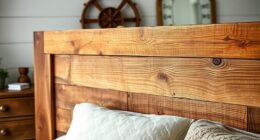To build an online presence for your woodworking brand, choose platforms like Instagram, YouTube, and Facebook to showcase high-quality images, tutorials, and community engagement. Develop content that highlights craftsmanship, share behind-the-scenes stories, and use SEO-rich hashtags to boost visibility. Create a cohesive visual identity with earthy tones and meaningful icons, and foster loyalty through live events and storytelling. Keep expanding your reach and connection—there’s more to discover as you grow your brand online.
Key Takeaways
- Utilize visual-centric platforms like Instagram and Pinterest to showcase craftsmanship and inspire potential clients.
- Create engaging content such as tutorials, behind-the-scenes videos, and storytelling to build emotional connections.
- Optimize your website and social media with targeted keywords, hashtags, and mobile-friendly design to increase visibility.
- Foster community through events, live demos, Q&A sessions, and active engagement to build loyalty and trust.
- Incorporate cohesive branding elements, including logo, color scheme, and industry-inspired visuals, to strengthen brand recognition.
Choosing the Ideal Social Media Platforms for Your Craft

Selecting the right social media platforms is essential for effectively showcasing your woodworking craft. You want to choose platforms that highlight your work’s visual appeal and connect with your target audience.
Instagram is perfect for sharing high-quality images of your projects, using Stories and IGTV to give followers behind-the-scenes access. Engaging with visual content marketing can help you attract more followers and showcase your craftsmanship effectively.
Instagram showcases your woodworking projects with stunning images and behind-the-scenes Stories.
YouTube allows you to create detailed tutorials, project showcases, and reviews, engaging viewers with your expertise.
Facebook helps you build a community through posts and groups, fostering loyalty and interaction.
Pinterest is ideal for inspiring users with your designs and ideas, attracting those seeking inspiration.
Twitter keeps your audience updated with quick news, promotions, and real-time feedback.
Picking the right mix ensures your craft reaches the right people effectively.
Developing Engaging Content to Showcase Your Work
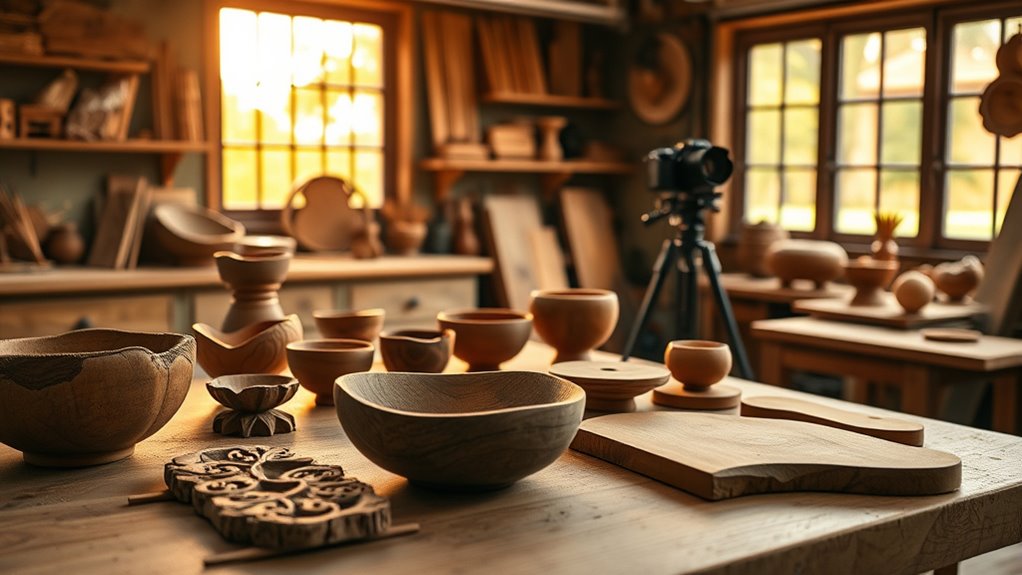
Creating engaging content is essential for effectively showcasing your woodworking skills and attracting your target audience. High-quality visuals play a vital role—use high-resolution images that highlight wood grain details and craftsmanship. Incorporate before-and-after videos to demonstrate project transformations, and rely on natural lighting to emphasize textures and finishes. Close-up shots of joinery and carvings bring attention to your technical skills, while maintaining consistent branding aesthetic across all visuals builds recognition. Educational content like step-by-step tutorials, infographics comparing wood types, safety guides, and project blueprints adds value for your followers. Share compelling stories behind your projects, including sourcing and inspiration, to create emotional connections. Additionally, understanding content themes such as the importance of storytelling and visual consistency can inspire innovative ideas for your woodworking brand that resonate with your audience. Engaging content not only displays your talent but also fosters trust and encourages audience interaction. Incorporating visual storytelling techniques can further elevate your online presence and make your work more memorable. Moreover, being aware of entertainment and parks support hours can help you plan your content creation schedule around your availability, ensuring consistent posting and engagement. To maximize impact, consider integrating minimalist design principles that reflect the elegance of simplicity and enhance your overall aesthetic.
Implementing Effective Marketing and Promotional Strategies
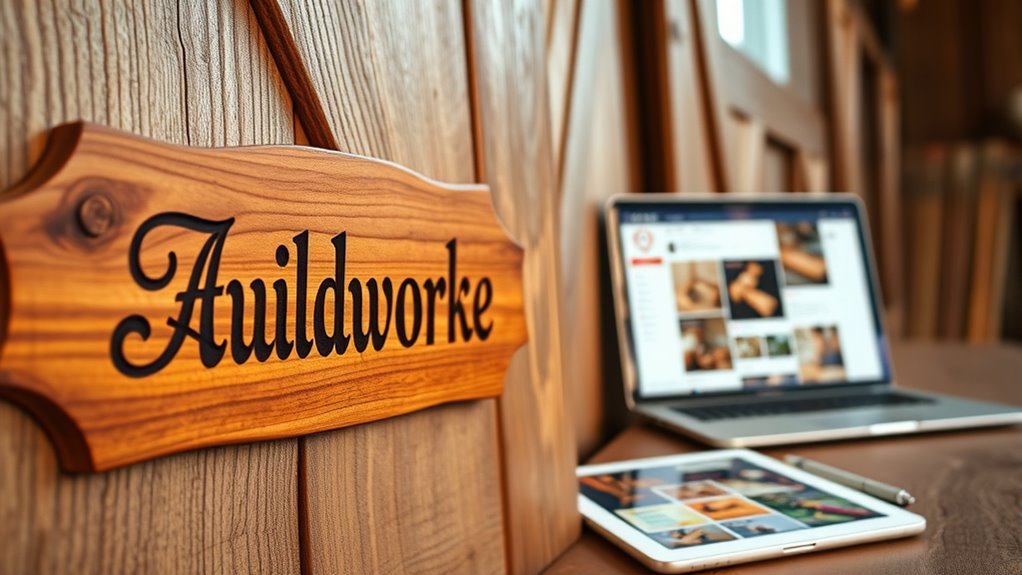
To successfully grow your woodworking business online, you need to implement targeted marketing and promotional strategies that reach your ideal audience.
Start by building a professional website and maintaining a blog to showcase your work and attract new customers.
Use email newsletters to keep your audience informed about new products, deals, and upcoming events, especially at craft shows.
Create engaging videos on YouTube to boost your visibility and credibility.
Partner with influencers or bloggers to extend your reach.
Monitor your efforts with analytics and customer feedback, then adjust your strategies accordingly.
Leverage social media platforms with interactive content, contests, and live sessions to foster engagement.
Consider local events like open houses and craft shows to build community connections and strengthen your brand presence offline.
Understanding color accuracy in your promotional visuals can significantly enhance the perceived quality of your products and attract more discerning customers.
Additionally, ensuring emotional support for your team can foster a positive work environment that encourages creativity and dedication.
Incorporating artistic influence into your branding materials can help your business stand out by highlighting craftsmanship and creativity, and staying informed about regional legal resources can ensure your promotional activities comply with local laws.
Being mindful of relationship dynamics within your team and customer interactions can also improve overall engagement and loyalty.
Enhancing Visibility With SEO and Hashtag Optimization
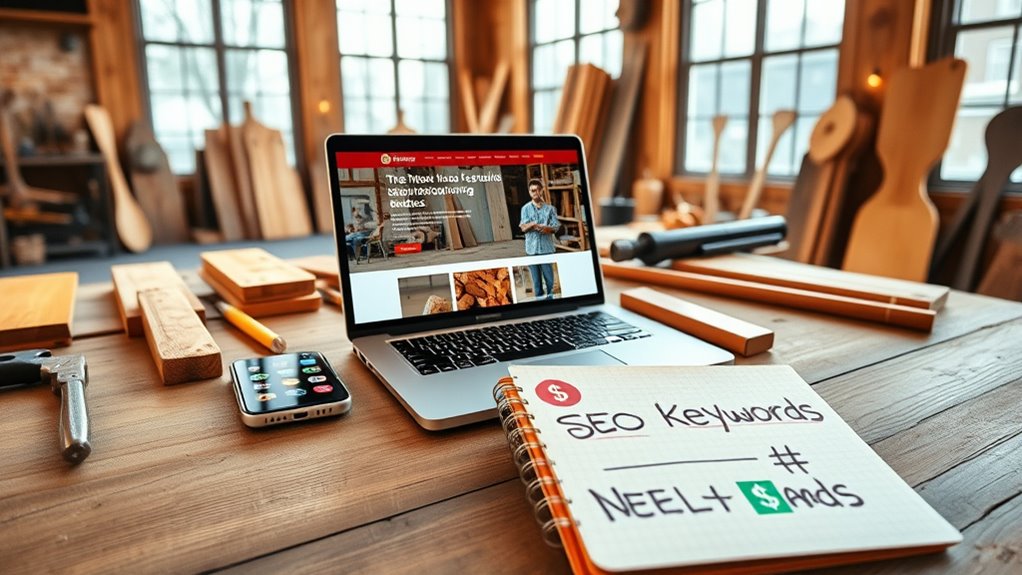
Enhancing your woodworking brand’s visibility online hinges on effective SEO and hashtag strategies that make your work discoverable. Start with keyword research—target long-tail keywords like “custom oak dining tables near me” to attract intent-driven searches, and incorporate local keywords such as “Portland woodworking shop” to boost regional visibility. Utilizing space optimization techniques can help you organize your website content more effectively, making it easier for search engines and visitors to find what they need. Additionally, understanding the history and traditions of Halloween can inspire themed content or promotions to engage your audience during the season.
Use tools like Google Keyword Planner and analyze competitors to find gaps and trending seasonal terms. Optimize your website with keyword-rich title tags, meta descriptions, header tags, and descriptive image alt-text. Guarantee your site is mobile-responsive and includes internal links. Incorporating relevant SEO best practices ensures your site ranks higher and reaches more potential customers.
For social media, use platform-specific hashtags (#WoodworkingProjects), niche tags (#LiveEdgeDesign), location-based tags (#NYCWoodworker), trending tags (#DIYHome), and branded hashtags (#YourBrandCrafts) to increase reach and engagement. Engaging with seasonal trends or holidays can also boost your visibility and connect with your audience more effectively.
Building a Community and Fostering Engagement
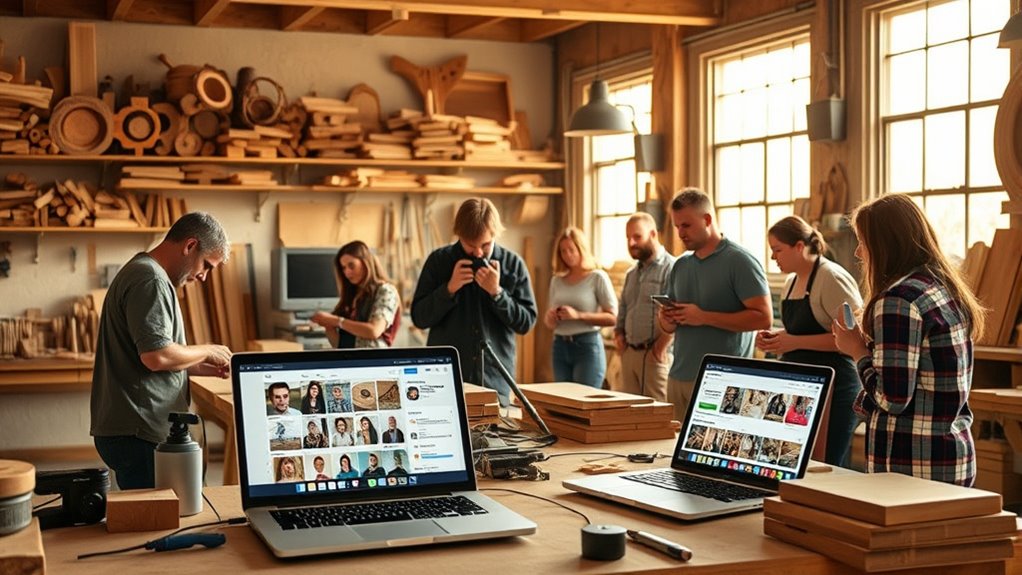
Building a strong community around your woodworking brand involves more than just showcasing finished pieces; it requires engaging your audience both online and offline. Hosting open-house events and workshops allows people to see techniques firsthand and get hands-on experience, deepening their connection to your work. Additionally, offering community engagement opportunities such as Q&A sessions or live demonstrations can foster trust and loyalty among your followers. Incorporating user interaction strategies, like comment prompts and feedback surveys, encourages active participation and strengthens bonds within your audience. Creating opportunities for feedback collection helps you better understand your audience’s preferences and improve your offerings. Inviting local influencers like interior designers or architects broadens your professional network and attracts new clients. Encouraging guests to bring friends and family creates organic growth. To further enhance your online presence, leveraging cybersecurity best practices ensures that your digital interactions remain safe and trustworthy for your community. Online, creating private groups on platforms like Facebook helps share exclusive tips, project photos, and trends, while user-generated content inspires others. Regular newsletters and interactive posts foster ongoing relationships, making your audience feel involved. Additionally, sharing stories about notable figures or family backgrounds related to your craft can add a personal touch that resonates with your audience family background. These efforts turn followers into loyal supporters who actively promote and advocate for your woodworking brand.
Crafting a Cohesive Visual Brand and Telling Your Story

Creating a cohesive visual brand for your woodworking business starts with carefully selecting elements that reflect your craftsmanship and values. Use icons like woodgrain, saw blades, chisels, and trees to instantly communicate your expertise. Incorporating symbols related to precious metals, such as gold bars or coins, can subtly suggest stability and value in your branding. Choose earthy tones such as browns, greens, and grays to evoke natural materials and sustainability. Adding accent colors like blue or red can help convey stability or energy. Ascertain your logo is scalable, maintaining clarity across all sizes, from business cards to signage. Pick fonts that match your brand personality—traditional for classic styles or bold for modern vibes—and keep typography consistent. Involve textures and patterns reminiscent of wood grain or metal to enhance visual storytelling and connect with your audience. Incorporate tools and textures thoughtfully, blending iconography with color and shape to tell your story visually. A well-crafted, balanced logo helps your brand stand out and tells customers what you stand for. For example, understanding Gold IRA and its features can inspire creative visuals and storytelling in your branding.
Frequently Asked Questions
How Often Should I Post on Each Social Media Platform?
You’re wondering how often to post on each social media platform.
For Instagram, aim for 3 to 5 times weekly and include daily stories to boost engagement.
On Facebook, post once daily for consistency.
On LinkedIn, 3 to 5 times weekly works best.
For Twitter, 2 to 3 posts daily keep you relevant, while TikTok benefits from 2 to 3 high-quality videos weekly.
Stay consistent and focus on quality.
What Type of Content Generates the Most Engagement for Woodworking Brands?
Ever wonder what truly drives engagement? Visual content like high-quality project photos, time-lapse videos, and before-and-after shots capture attention and evoke emotion.
Educational content such as tutorials and downloadable plans provide value, while community posts and customer projects foster trust.
Do you see how combining inspiring visuals with helpful, authentic stories creates a powerful connection? Focus on these content types to boost interaction and build a loyal woodworking audience.
How Can I Measure the Success of My Online Marketing Efforts?
To measure your online marketing success, focus on key metrics like conversion rate, which shows how many visitors take action, and engagement rate to gauge audience interaction.
Track website traffic and bounce rate for overall performance, and monitor ROI to see if your campaigns are profitable.
Keep an eye on customer lifetime value and customer acquisition cost to assess long-term growth and marketing efficiency.
What Are Cost-Effective Ways to Grow My Online Woodworking Community?
To grow your online woodworking community cost-effectively, focus on creating engaging content like tutorials, project stories, and behind-the-scenes videos.
Use social media platforms like Instagram and Pinterest to showcase your work and encourage community sharing.
Partner with influencers or other woodworkers for collaborations, run hashtag campaigns, and host live Q&A sessions.
Engage with your audience regularly, respond to comments, and promote user-generated content to build loyalty without big expenses.
How Do I Handle Negative Comments or Online Criticism Effectively?
When handling negative comments or online criticism, thank the commenter for their feedback to show professionalism.
Respond promptly, keeping your reply brief and respectful.
If the issue is serious, invite them to discuss privately to resolve the matter.
Use negative feedback as an opportunity to improve your work, and always aim to turn criticisms into constructive insights that help boost your reputation and strengthen your brand.
Conclusion
Building your online presence might seem overwhelming, but with consistent effort, you’ll see your woodworking brand grow. Even if you’re not tech-savvy, starting small with social media and sharing your story can make a big difference. Remember, progress takes time—don’t get discouraged by slow growth at first. Stay passionate, keep engaging, and your community will expand, turning your craftsmanship into a thriving online business.






